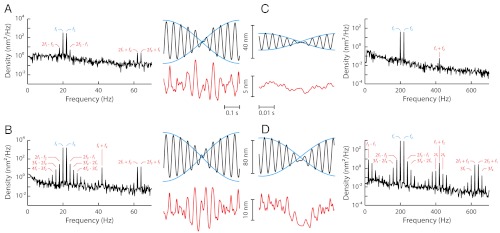Fig. 3.
Two-tone distortions. Hair-bundle response to the sum  of two sinusoidal forces with equal amplitudes
of two sinusoidal forces with equal amplitudes  (2 pN, A and C; 10.1 pN, B and D). Two-tone stimulation was delivered at resonance (A and B), with f1 = 20 Hz and f2 = 22 Hz near the bundle’s characteristic frequency of spontaneous oscillations fC = 20 Hz, or off-resonance (C and D; f1 = 200 Hz and f2 = 220 Hz). The hair-bundle motion displayed a periodic beating pattern of magnitude; the ensemble average of 40 (A and B) or 400 (C and D) beats is plotted here (black line). The spectral density of bundle movement is shown on the side of each temporal trace for 20 s of recording. The frequencies of the distortion products are labeled in red. Keeping only the Fourier components f1 and f2 of the primaries resulted in a beating pattern of motion with an envelope (blue line) that is superimposed on the bundle’s global response. Conversely, filtering the primaries disclosed, in the temporal domain, the waveform of distortion (red line) that the hair bundle introduced into its response to the stimulus.
(2 pN, A and C; 10.1 pN, B and D). Two-tone stimulation was delivered at resonance (A and B), with f1 = 20 Hz and f2 = 22 Hz near the bundle’s characteristic frequency of spontaneous oscillations fC = 20 Hz, or off-resonance (C and D; f1 = 200 Hz and f2 = 220 Hz). The hair-bundle motion displayed a periodic beating pattern of magnitude; the ensemble average of 40 (A and B) or 400 (C and D) beats is plotted here (black line). The spectral density of bundle movement is shown on the side of each temporal trace for 20 s of recording. The frequencies of the distortion products are labeled in red. Keeping only the Fourier components f1 and f2 of the primaries resulted in a beating pattern of motion with an envelope (blue line) that is superimposed on the bundle’s global response. Conversely, filtering the primaries disclosed, in the temporal domain, the waveform of distortion (red line) that the hair bundle introduced into its response to the stimulus.

